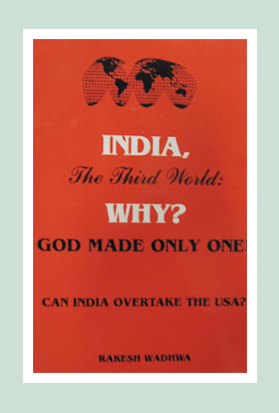The Chinese Transformation
China today offers us the amazing scenario of a country marching towards economic freedom while remaining politically unfree. Even as the communist rulers of China liberalize their country for business and welcome foreign capital, they maintain their stranglehold on political power.
The result of the loosening of the State’s grip over the economy has been stunning: since 1980, the Chinese per capital income has more than tripled, over 200 million of its people have moved from poverty into middle class, foreign investment has soared to almost US$50 billion exceeding what is invested in India by foreigners by a factor of 20, and it has become one of the world’s principal exporters with its US$350 billion in export of services and goods – beating India’s export by over four times.
Government in China has been slowly but surely reducing its role in the economy. State owned enterprises which accounted for over 80% of the Chinese industrial output prior to 1980 now account for half that figure. This while exports from privately owned companies have skyrocketed. Shenzen, one of China’s dynamic coastal provinces has seen its exports rise from US$17 million in 1980 to US$6 billion in 1991 and today its exports exceed US$35 billion.
This transformation has occurred even as China remains undemocratic; dissent is virtually nonexistent after the Tiananmen square massacre. What this tells us is that however desirable democracy may be for other reasons, it is not indispensable for a country in achieving prosperity and wealth.
Singapore became wealthy under the iron-fisted rule of Lee Kuan Yew. Singapore did not offer parliamentary, electoral, and press freedom to its people as India did. Singapore, however, unlike India and Nepal, gave its people economic freedom soon after the end of World War II. The result: Singapore today is one of the world’s wealthiest economies: its people earn an annual average income of US$27,000.
China’s transformation too is taking place under the iron-hand of its communist rulers. In the first decade of its economic reforms, though China saw mounting political dissent, it was mercilessly quashed: tanks, troops, and bullets were employed in the 1989 attack by the government on demonstrators at Tiananmen.
Economic reforms however continued. Controls on foreign exchange were loosened in the 1990’s leading to the present boom in investments from the US and the rest of the world. Today the world invests more in China than in the US. Stock markets – the prime symbol of capitalism – were set up in Shanghai and Shenzen in the early 90s.
In 1992, the supreme leader of China, Deng Xiaoping, acting more like the free-market Lee Kuan Yew of Singapore than a Maoist, spoke out in favour of the free market policies being followed by the coastal regions of Guangzhou and Shenzen. What happened? All dissent to open market policies was effectively shut up. Who was going to dare speak up against the supreme leader himself? These coastal regions largely freed from bureaucratic red tape and over-bearing controls grew at a sizzling 15% annual rate.
From then onwards there has been no looking back for China. Chinese people, who were at one time called no-good-opium-eaters by their colonial masters, shook the world with their ability to flood every market with goods. The efficiency of Chinese firms makes its competitors quake with fear.
This is not to say that things can’t go wrong in China. The government still exercises controls over vast areas of its economy and that’s where the danger lies. China’s controls over its currency and its inefficient and outmoded State enterprises can lower its growth. Other than that things are good and getting better.
Lessons for Nepal: all it needs is one strong leader who can give the people economic freedom, nothing else is going to make Nepal rich. Democracy and political freedom, important as they may be, are not going to result in Nepal’s progress. That is what we understand from what has happened in China and Singapore over the last few decades.
The Himalyan Times
 Rakesh Wadhwa. Ever since, I was a school boy, I knew India was on the wrong path. Socialism was just not what we needed to get ahead. Government controlled our travel; government controlled our ability to buy and sell; and government controlled our freedom to move our money. My life has focused on the inherent rights people have. When I was in college, I never understood, what the governments meant by their "socialistic attitude". If people are free to buy, sell and move their capital themselves without any restrictions by state, then the welfare of people is inevitable & hence the countries they live in will become wealthy. The government has no right whatsoever, to point a finger at me or my business. I am not a revolutionary. I just want to light up my cigarette and not get nagged about it. I believe in non-interfering attitude to attain more.
Rakesh Wadhwa. Ever since, I was a school boy, I knew India was on the wrong path. Socialism was just not what we needed to get ahead. Government controlled our travel; government controlled our ability to buy and sell; and government controlled our freedom to move our money. My life has focused on the inherent rights people have. When I was in college, I never understood, what the governments meant by their "socialistic attitude". If people are free to buy, sell and move their capital themselves without any restrictions by state, then the welfare of people is inevitable & hence the countries they live in will become wealthy. The government has no right whatsoever, to point a finger at me or my business. I am not a revolutionary. I just want to light up my cigarette and not get nagged about it. I believe in non-interfering attitude to attain more. 
 The Bastiat Award is a journalism award, given annually by the International Policy Network, London. Bastiat Prize entries are judged on intellectual content, the persuasiveness of the language used and the type of publication in which they appear. Rakesh Wadhwa won the 3rd prize (a cash award of $1,000 and a candlestick), in 2006.
The Bastiat Award is a journalism award, given annually by the International Policy Network, London. Bastiat Prize entries are judged on intellectual content, the persuasiveness of the language used and the type of publication in which they appear. Rakesh Wadhwa won the 3rd prize (a cash award of $1,000 and a candlestick), in 2006.
2 Comments
Bertie
December 8, 2011IMHO you’ve got the right answr!
Cihanjuang
February 14, 2012Nepal is like a yam bweeten two rocks. In fact the dispute bweeten India and China regarding Kalapani has mingled Nepal as a tool.Of course the Sugauli treaty is unfair. India must realize it and other international communities should also look at this issue.